Resource allocation and capacity planning for different departments or locations.
Resource allocation and capacity planning are crucial aspects for the smooth operation of companies with different departments or locations. Effective planning and allocation of resources is of great importance to increase efficiency, optimize costs and ensure customer satisfaction. . This article highlights what is important in site-based resource and capacity planning, challenges that can arise, an in-depth explanation of how to perform this process, and how resource planning software can help.

The importance of site-based resource and capacity planning.
Location-based resource and capacity planning is critical because it ensures that resources such as labor, machinery, finances, and materials are used efficiently. This is especially important when a company has multiple departments or locations. Here are some important aspects to consider in this planning:
Needs analysis:
Before resources are allocated, a thorough needs analysis is required. Each site or department has different needs and priorities. It is important to understand these differences to ensure that resources are allocated where they are needed most.
Flexibility:
Planning should be flexible to adapt to changing needs. Sites may evolve over time, and it is important that resource allocation reflect these changes.
Prioritization:
Resources should be allocated based on priority. Critical functions or sites should have priority over less important ones. This helps avoid bottlenecks and ensures that key business objectives are met.
Data Analysis:
Comprehensive data analysis is necessary to make informed decisions. Software solutions can collect and analyze data from multiple locations to identify trends and patterns that help with planning.
Difficulties and obstacles
Several difficulties and obstacles can arise in site-based resource and capacity planning:
Communication: Communication between different sites or departments can be a challenge. It is important to ensure that information and requirements are effectively shared to enable accurate planning.
Complexity: The larger and more diverse the organization, the more complex planning becomes. It can be difficult to consider all relevant factors while keeping track of everything.
Limited Resources: Sometimes limited resources are available and it is difficult to meet all the requirements. In such cases, it is critical to make wise prioritization decisions.
Changes in the market: External factors such as market fluctuations or geopolitical events can affect planning and require quick adjustments.
Steps to site-based resource and capacity planning.
Site-based resource and capacity planning is a complex process that requires careful planning and coordination. The following steps may be helpful:
1. Needs assessment and goal setting:.
Identify the goals and priorities for each site or department. What resources are needed to achieve these goals? Record the current resource needs and capacity of each site.
2. Data integration:
Gather relevant data from different sites or departments. This may include financial, operational, personnel, and logistical information. Use resource planning software to centralize this data and present it in a consistent format.
3. Analysis and Modeling:
Utilize the resource planning software to analyze data and create models. You can use historical data to identify trends or conduct scenario analyses to predict future needs. Consider various scenarios such as growth, downturn, or new market developments.
4. Resource Allocation:
Based on the analyses and models, make decisions regarding resource allocation. Which location requires which resources? Which department takes priority? Take into account budget constraints and resource availability.
5. Communication and Coordination:
Ensure that all relevant parties are informed about the decisions made. This can facilitate communication between locations and departments. Use the collaboration features of the resource planning software to support information exchange.
6. Monitoring and Adjustment:
Implement resource allocation and continuously monitor the performance of locations and departments. If conditions change or goals shift, adjust resource planning accordingly.
Software Solutions for Resource Allocation
Modern software solutions provide valuable support for location-based resource and capacity planning. Here are some features that such solutions can offer:
Software can automate many routine tasks, such as data collection and report generation, to expedite the planning process.
Modern software solutions can analyze large volumes of data to identify trends and patterns. This assists in making informed decisions and predicting future needs.
Collaboration features allow teams at different locations to collaborate in real-time and exchange information.
Software can simulate scenarios to see how different decisions would affect resource allocation. This aids in selecting the best options.
Overall, location-based resource and capacity planning is a complex but crucial process for businesses with multiple locations or departments. The right software solution can help companies plan more efficiently, avoid bottlenecks, and increase customer satisfaction. It’s important to be aware of the challenges and use the right tools for success.
Rillsoft Project as a Resource Allocation and Capacity Planning Solution
What does our software solution, Rillsoft Project, offer in terms of location-based resource and capacity planning, and how can it be used:
Data Centralization: Rillsoft Project allows companies to store and manage all information about resources and capacities at different locations or in different departments in one place. This simplifies data integration and management.
Visual Representation: The software provides a visual representation of resources and capacities, enabling quick identification of bottlenecks and availabilities at a glance. This simplifies analysis and modeling.
Collaboration: Rillsoft Project offers collaboration features that enable teams at different locations to work together in real-time. Information can be exchanged quickly, and decisions can be made collaboratively.
Flexibility: The software allows for quick adjustments to resource plans to accommodate changes in demand or goals. This supports the flexibility required for effective location-based resource planning.
Reporting and Analysis: Rillsoft Project offers reporting features that allow for monitoring the performance of locations and departments and making informed decisions.
The selection of suitable resource planning software depends on the specific requirements of your company and industry. It’s important to ensure that the chosen software provides the features necessary for successful location-based resource and capacity planning.
